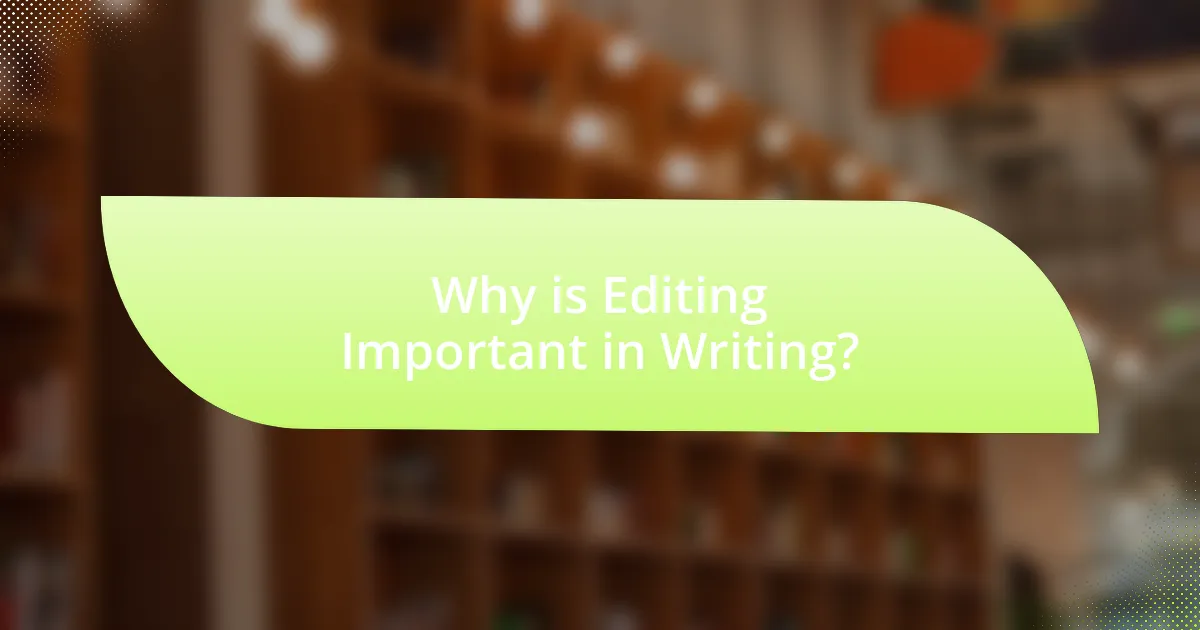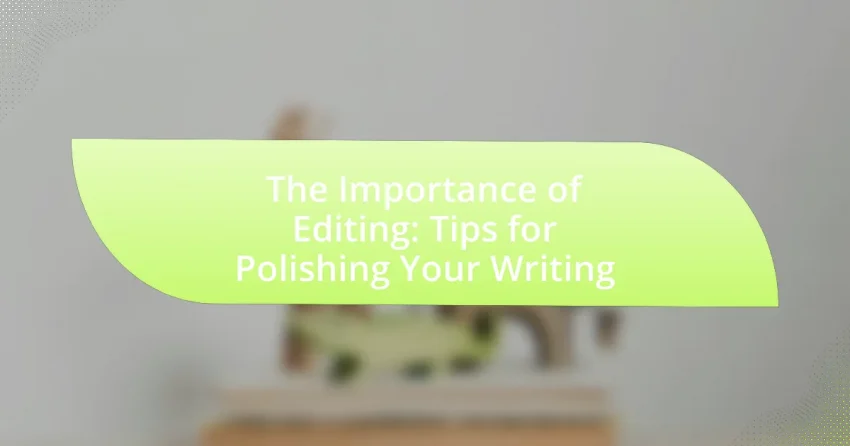The article emphasizes the critical role of editing in writing, highlighting its importance in enhancing clarity, coherence, and overall quality. It discusses various types of editing, including developmental, substantive, copy editing, and proofreading, each serving distinct purposes in the writing process. Key elements refined through editing, such as grammar, punctuation, and style, are explored, along with common mistakes that can be identified and corrected. Additionally, the article provides practical tips for effective editing, including the use of tools and resources, strategies for improvement, and the significance of maintaining the writer’s voice while ensuring professionalism and credibility.

Why is Editing Important in Writing?
Editing is important in writing because it enhances clarity, coherence, and overall quality of the text. Through the editing process, writers can identify and correct grammatical errors, improve sentence structure, and ensure that ideas flow logically. Research indicates that effective editing can increase reader engagement and comprehension, as studies show that well-edited texts are more likely to hold the reader’s attention and convey the intended message accurately. For instance, a study published in the Journal of Writing Research found that texts with fewer errors and clearer organization significantly improved reader understanding and retention.
What role does editing play in the writing process?
Editing plays a crucial role in the writing process by refining and enhancing the clarity, coherence, and overall quality of a written piece. This stage allows writers to identify and correct grammatical errors, improve sentence structure, and ensure that the content effectively communicates its intended message. Research indicates that effective editing can significantly increase the readability and impact of a text, as evidenced by studies showing that well-edited documents are more likely to engage readers and convey professionalism.
How does editing improve clarity and coherence in writing?
Editing improves clarity and coherence in writing by refining the structure, eliminating ambiguity, and enhancing the flow of ideas. Through the process of editing, writers can identify and correct grammatical errors, awkward phrasing, and inconsistencies that may confuse readers. For instance, a study published in the Journal of Writing Research found that well-edited texts are more easily understood and retain reader engagement, demonstrating that clarity directly correlates with effective communication. Additionally, coherence is achieved by ensuring that ideas are logically organized and transitions between sentences and paragraphs are smooth, which helps readers follow the writer’s argument or narrative seamlessly.
What are the common mistakes that editing can help identify?
Editing can help identify common mistakes such as grammatical errors, punctuation issues, spelling mistakes, and inconsistencies in tone or style. These errors often detract from the clarity and professionalism of the writing. For instance, a study by the American Psychological Association highlights that grammatical errors can lead to misinterpretation of the text, affecting the reader’s understanding. Additionally, punctuation mistakes can change the meaning of sentences, as demonstrated by the difference between “Let’s eat, Grandma!” and “Let’s eat Grandma!” This illustrates the critical role editing plays in ensuring effective communication.
How does editing enhance the overall quality of a piece?
Editing enhances the overall quality of a piece by refining its clarity, coherence, and correctness. Through the process of editing, writers can eliminate grammatical errors, improve sentence structure, and ensure that ideas flow logically, which ultimately leads to a more polished and professional final product. Research indicates that well-edited texts are more likely to engage readers and convey the intended message effectively, as evidenced by studies showing that clarity in writing significantly impacts reader comprehension and retention.
What specific elements of writing are refined through editing?
Editing refines several specific elements of writing, including clarity, coherence, grammar, punctuation, and style. Clarity is enhanced by removing ambiguity and ensuring that the message is easily understood. Coherence is improved by organizing ideas logically, allowing for a smoother flow of information. Grammar and punctuation corrections eliminate errors that can distract readers and undermine credibility. Finally, style adjustments ensure that the writing is appropriate for the intended audience and purpose, enhancing overall engagement. These elements are critical for effective communication and are consistently emphasized in writing guides and educational resources.
How does editing contribute to the writer’s credibility?
Editing enhances a writer’s credibility by ensuring clarity, accuracy, and professionalism in their work. When a piece is meticulously edited, it reflects the writer’s commitment to quality and attention to detail, which fosters trust among readers. Research indicates that well-edited texts are perceived as more authoritative; for instance, a study published in the Journal of Business Communication found that errors in writing can significantly diminish a writer’s perceived expertise. Thus, effective editing not only improves the overall quality of the writing but also reinforces the writer’s reliability and authority in their subject matter.

What are the Different Types of Editing?
The different types of editing include developmental editing, substantive editing, copy editing, and proofreading. Developmental editing focuses on the overall structure and content of a manuscript, ensuring that the narrative flows logically and effectively. Substantive editing involves refining the text for clarity, coherence, and style, addressing issues such as tone and voice. Copy editing is concerned with correcting grammar, punctuation, and spelling errors, as well as ensuring consistency in formatting. Proofreading is the final step, where the text is checked for any remaining errors before publication. Each type of editing plays a crucial role in enhancing the quality of writing, contributing to a polished final product.
What distinguishes developmental editing from copy editing?
Developmental editing focuses on the overall structure, content, and flow of a manuscript, while copy editing concentrates on grammar, punctuation, and style consistency. Developmental editing involves assessing the narrative arc, character development, and thematic elements, ensuring that the work effectively communicates its intended message. In contrast, copy editing is concerned with correcting errors and improving clarity at the sentence level, ensuring that the text adheres to specific style guides. This distinction is crucial for writers to understand, as each type of editing serves a different purpose in the writing process.
How does developmental editing shape the structure and content?
Developmental editing shapes the structure and content by providing a comprehensive analysis of a manuscript’s organization, themes, and character development. This type of editing focuses on the overall flow and coherence of the narrative, ensuring that each section contributes effectively to the story’s progression. For instance, developmental editors assess plot arcs, pacing, and character motivations, making recommendations that enhance clarity and engagement. By addressing these elements, developmental editing helps writers create a more compelling and cohesive work, ultimately improving the reader’s experience.
What aspects does copy editing focus on for grammatical accuracy?
Copy editing focuses on several key aspects for grammatical accuracy, including punctuation, sentence structure, verb tense consistency, subject-verb agreement, and word choice. These elements ensure that the text adheres to standard grammatical rules, enhancing clarity and readability. For instance, proper punctuation helps to convey the intended meaning of sentences, while consistent verb tenses maintain a coherent timeline in the narrative. Additionally, ensuring subject-verb agreement prevents confusion about the relationships between different parts of a sentence. By addressing these aspects, copy editing significantly improves the overall quality of written content.
What is the significance of proofreading in the editing process?
Proofreading is crucial in the editing process as it ensures the final text is free from errors and maintains clarity. This step involves checking for grammatical mistakes, spelling errors, and punctuation issues, which can significantly affect the reader’s understanding and perception of the content. Research indicates that documents with fewer errors are perceived as more credible and professional, enhancing the overall quality of the writing. Thus, proofreading not only improves accuracy but also reinforces the writer’s credibility and the effectiveness of the communication.
How does proofreading differ from other types of editing?
Proofreading differs from other types of editing primarily in its focus on surface-level errors rather than content or structure. While editing encompasses a broader range of tasks, including improving clarity, flow, and overall coherence of the text, proofreading specifically targets spelling, grammar, punctuation, and formatting mistakes. This distinction is crucial because proofreading is typically the final step in the writing process, ensuring that the document is polished and free of errors before publication or submission.
What common errors are typically caught during proofreading?
Common errors typically caught during proofreading include spelling mistakes, grammatical errors, punctuation issues, and inconsistencies in formatting. Spelling mistakes can range from simple typos to incorrect word usage, while grammatical errors often involve subject-verb agreement and sentence structure. Punctuation issues may include misplaced commas or periods, which can alter the meaning of sentences. Inconsistencies in formatting can manifest as variations in font size, style, or spacing throughout the document. These errors are crucial to identify as they can significantly impact the clarity and professionalism of the writing.

What Tips Can Help You Polish Your Writing Through Editing?
To polish your writing through editing, focus on clarity, conciseness, and coherence. Clarity ensures that your ideas are easily understood; use simple language and avoid jargon unless necessary. Conciseness involves eliminating unnecessary words and phrases, which enhances readability. Coherence requires that your writing flows logically, with clear connections between sentences and paragraphs.
For instance, a study by the University of Oxford found that concise writing improves reader comprehension by up to 30%. Additionally, employing tools like Grammarly or Hemingway can help identify areas for improvement, making the editing process more efficient.
How can you effectively approach the editing process?
To effectively approach the editing process, begin by reviewing the content for clarity and coherence. This involves reading the text multiple times, focusing on different aspects such as structure, grammar, and style in each pass. Research indicates that a systematic approach, such as the one outlined by the American Psychological Association, enhances the quality of writing by ensuring that each element is scrutinized thoroughly. By breaking down the editing into stages—content editing, line editing, and proofreading—editors can identify and rectify issues more efficiently, leading to a polished final product.
What strategies can be used to identify areas needing improvement?
To identify areas needing improvement in writing, one effective strategy is to conduct a thorough review using a checklist that focuses on common writing issues such as grammar, clarity, and coherence. This method allows writers to systematically evaluate their work against established standards. Research indicates that utilizing peer feedback can also highlight overlooked weaknesses, as different perspectives often reveal issues that the original writer may not notice. Additionally, employing tools like readability scores can provide quantitative data on the text’s complexity, guiding writers to simplify or clarify their language.
How can feedback from others enhance your editing efforts?
Feedback from others can significantly enhance your editing efforts by providing diverse perspectives that identify areas for improvement. When individuals review your work, they can spot inconsistencies, unclear phrasing, or logical gaps that you may overlook due to familiarity with the text. Research indicates that peer feedback can lead to a 20% increase in the quality of written work, as it encourages critical thinking and fosters a collaborative approach to editing. This collaborative process not only improves the clarity and coherence of the writing but also enhances the overall effectiveness of the communication.
What tools and resources are available for effective editing?
Effective editing can be achieved using various tools and resources such as Grammarly, Hemingway Editor, and ProWritingAid. Grammarly offers real-time grammar and style suggestions, making it a popular choice among writers for enhancing clarity and correctness. Hemingway Editor focuses on readability, highlighting complex sentences and passive voice, which helps streamline writing. ProWritingAid combines grammar checking with style suggestions and in-depth reports, providing comprehensive feedback on writing quality. These tools are widely recognized in the writing community for their effectiveness in improving written content.
Which editing software can assist in the editing process?
Editing software that can assist in the editing process includes Grammarly, ProWritingAid, and Adobe Acrobat. Grammarly provides real-time grammar and style suggestions, enhancing clarity and correctness in writing. ProWritingAid offers in-depth reports on writing style, grammar, and readability, making it suitable for comprehensive editing. Adobe Acrobat allows for PDF editing and markup, facilitating collaboration and feedback on written documents. These tools are widely recognized for their effectiveness in improving writing quality, as evidenced by user reviews and industry recommendations.
How can style guides improve consistency in writing?
Style guides improve consistency in writing by providing a standardized set of rules and guidelines for language usage, formatting, and style. These guides ensure that all writers adhere to the same conventions, which minimizes variations in tone, terminology, and structure across different documents. For example, the Chicago Manual of Style and the APA Publication Manual offer specific instructions on citation formats, which helps maintain uniformity in academic writing. Research indicates that adherence to style guides can enhance readability and comprehension, as consistent formatting allows readers to navigate texts more easily.
What are some common pitfalls to avoid during editing?
Common pitfalls to avoid during editing include overlooking grammatical errors, failing to maintain consistency in style and tone, and neglecting to read the text aloud. Overlooking grammatical errors can lead to a lack of professionalism, as studies show that 59% of readers are less likely to trust content with grammatical mistakes. Failing to maintain consistency in style and tone can confuse readers, as inconsistent messaging can dilute the intended impact of the writing. Neglecting to read the text aloud often results in missing awkward phrasing or unclear sentences, which can hinder the overall flow and clarity of the piece.
How can over-editing negatively impact your writing?
Over-editing can negatively impact your writing by stifling creativity and leading to a loss of original voice. When writers excessively revise their work, they may become overly focused on technical aspects, such as grammar and punctuation, which can detract from the overall message and emotional resonance of the piece. Research indicates that excessive editing can result in a disjointed narrative, as the writer may alter or remove essential elements that contribute to the flow and coherence of the text. Additionally, over-editing can create a sense of frustration and self-doubt, ultimately hindering the writer’s confidence and willingness to express ideas freely.
What should you keep in mind to maintain your voice while editing?
To maintain your voice while editing, focus on consistency in tone, style, and word choice. Consistency ensures that your unique voice remains recognizable throughout the text, which is crucial for engaging your audience. For instance, if your writing is conversational, avoid overly formal language or jargon that could alienate readers. Additionally, be mindful of sentence structure and rhythm; abrupt changes can disrupt the flow and dilute your voice. Research indicates that maintaining a consistent voice enhances reader connection and comprehension, as seen in studies on narrative engagement.
